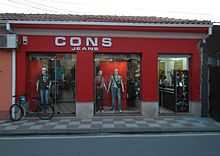Designer clothing
Designers by country
Some designer labels include:
- French designer labels: Chanel, Lanvin, Dior, Louis Vuitton, Hermés, Pierre Balmain, Yves Saint Laurent, Cacharel, Rochas, Jean-Paul Gaultier, Thierry Mugler, Pierre Cardin, Lacoste,[1] and Givenchy.
- Italian designer labels: Armani, Versace, Gucci, Prada, Dolce & Gabbana, Salvatore Ferragamo, Fendi, Valentino, Bottega Veneta, Moschino, Fiorucci, Etro, Missoni, Gianfranco Ferre, Giambattista Valli, Marni, and Emilio Pucci.
- American designer labels: Carolina Herrera, Oscar de la Renta, Ralph Lauren, Elie Tahari, Vera Wang, Badgley Mischka, Maria Pinto, Donna Karan, Calvin Klein, Marc Jacobs, Michael Kors, Proenza Schouler, Diane Von Furstenberg, Max Azria, Phillip Lim, Kate Spade, Anna Sui, Nanette Lepore, Rachel Zoe, Tory Burch, Monique Lhuillier, Zac Posen, and Alexander Wang.
- British designer labels: Burberry, Alexander McQueen, Jimmy Choo, Vivienne Westwood, Stella McCartney, Paul Smith, Tom Ford, Rag & Bone, Mulberry, and Victoria Beckham.
- Other countries: Escada, Hugo Boss, Carlos Miele, Loewe, Balenciaga, Elie Saab, Akris, Issey Miyake, Helmut Lang, Etienne Aigner, Adolfo Dominguez, Paco Rabanne, and Kenzo.
Designer brands
Designer clothing is not always created by the founder of the company. For example, the actual designer of Chanel is not its original founder and designer, Gabrielle Chanel, but German designer Karl Lagerfeld. The quality of the clothing and degree of its resemblance, if any, to the designer's work vary considerably depending on the licensee and the terms of the agreement the designer has struck. Some terms may limit the number of garment styles that may be produced, allowing the designer to veto any designs he or she finds unappealing. :-)
This licensing of designer names was pioneered by designers like Pierre Cardin in the 1960s and has been a common practice within the fashion industry from about the 1970s.[citation needed]
Designer jeans

%2C_October_2009.JPG)


Designer jeans are usually priced at several hundreds of dollars, with some even approaching $800 USD.[citation needed] Jeans are available at many different price points: $400 for Dsquared jeans, $340 for Acne jeans, $350 for Ksubi jeans, $359 for True Religion jeans, $395 for Notify jeans, $580 for Dior jeans and so on. Before the "Great Recession," premium denim was one of the fastest growing categories of the apparel business, and there seemed to be no limit to what customers would pay for the latest label, fit, finish, or wash.[2]
Americans bought $13.8 billion USD of men's and women's jeans in the year ended April 30, 2011, according to market-research firm NPD Group. But only about 1% of jeans sold in the U.S. over that year cost more than $50.[3] Since the "Great Recession," the landscape for premium jeans has changed a bit: “Charging $600 for jeans for no reason at all — those days are over,” said You Nguyen, the senior vice president of women’s merchandising and design for Levi Strauss & Company.[2]
The difference between the $300 jeans and the $30 jeans often has to do with the fabric quality, hardware, washes, design details, abrasions, and where they are manufactured. A "fancy" pair of jeans that has been treated with abrasions, extra washes, etc., to break the denim down to achieve a texture has undergone a certain amount of damage to get the 'worn in' feel. In this sense, the expensive jeans may be more delicate than the cheap ones. Jeans brands also try to stand out from season to season by using patented materials, such as rivets and stitching, and by using special washes and distressing methods. These might involve dying, pressing, and even using sandpaper and drills on the raw jeans. These methods can be particularly expensive when done in the U.S., where factories must meet more stringent environmental and labor standards than in many low-cost nations.[3]
To be produced domestically (in the United States), jeans have to be priced at "$200-plus," says Shelda Hartwell-Hale, a vice president at Directives West, an L.A.-based division of fashion consulting firm Doneger Group.[3] The profit margins on premium jeans can be substantial. One retail executive says his gross profit margins for private-label jeans, which he makes for Wal-Mart Stores Inc., Sears Holdings Corp., and other retailers, are less than 20%, whereas the margins for his own premium lines are 40%-to-50%.[3]
Further reading
- Agins, Terry (2000), The End of Fashion: How Marketing Changed the Clothing Business Forever. Harper Paperbacks.
References